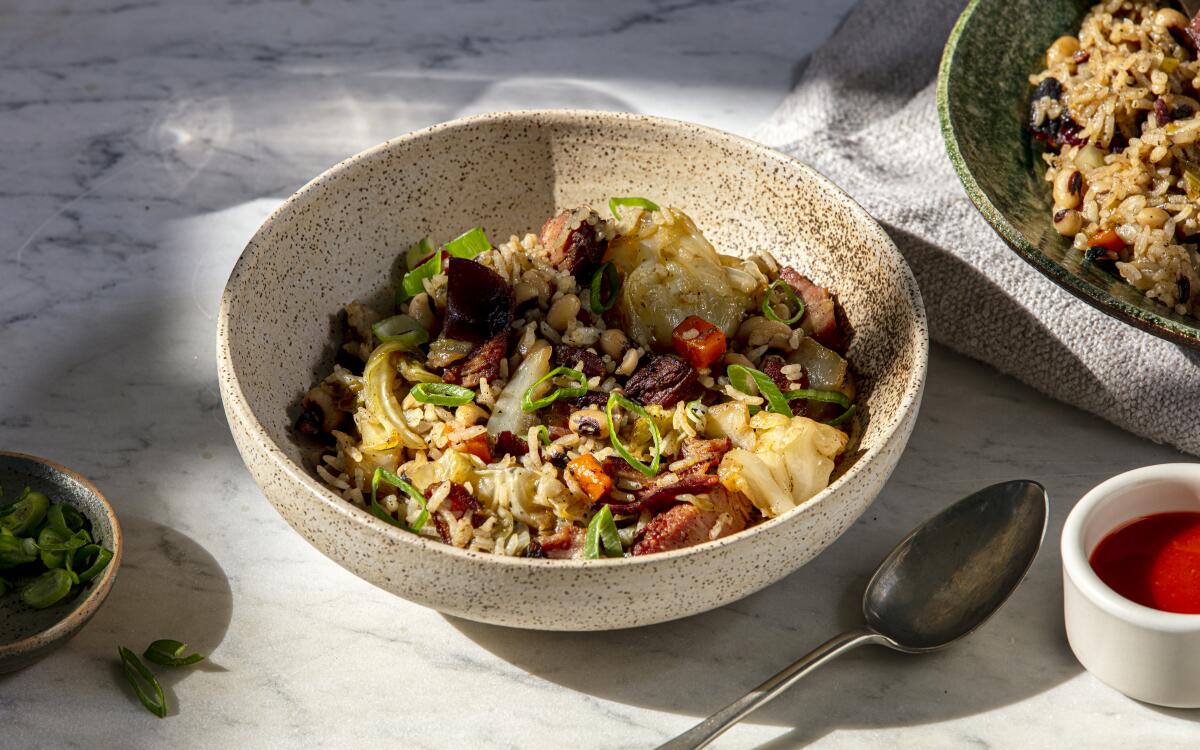Hoppin' John

In Dakar, Senegal, it’s called thiebou niébé (che-boo nee-eb-bay). It’s a dish that traveled across the Middle Passage, stowed in the memories of the enslaved Africans who built what Karen Hess called the Carolina Rice Kitchen. The halal smoked and fermented fish of West Africa was forcefully exchanged for Lowcountry smoked pork and Christianity. Nowadays, it’s a dish traditionally enjoyed around New Year’s for good luck. I indulge my craving for it all year round. Hoppin’ John is the story of African American cuisine in a bowl.
This is how my mother made it. The recipe calls for making a pot of black-eyed peas and a large batch of cooked rice — both elements of the hoppin’ John — in amounts that are greater than what you’ll need for the finished dish. You can save the leftovers in the refrigerator to make the dish again later, or you can multiply the bacon, ham and cabbage used to finish the dish and cook them in batches to have a finished dish that feeds more people.
The day before, prepare and cook the peas: Pour the peas into a large bowl, cover with plenty of cold water, and let soak for 4 hours.
Meanwhile, dice the carrots, onion, celery and jalapeño, and finely chop the garlic. Combine the vegetables in one bowl and add the bundle of thyme sprigs and 1 bay leaf.
Cook the peas: Heat the olive oil in a large saucepan or heavy-bottomed Dutch oven over high heat until it begins to ripple. Add the chopped vegetables and herbs, season with a large pinch of salt, then lower the heat to medium-high. Cook, stirring frequently, until the onions are translucent, 6 to 8 minutes. Drain the peas and then add them to the pot. Pour in enough water to cover the peas by at least 2 inches and bring to a boil. Let boil for 5 minutes, then reduce the heat to maintain a gentle simmer. Cook, stirring occasionally, until the beans are tender enough to easily squeeze between your thumb and forefinger (having a slotted spoon on hand aides in pea retrieval), 20 to 30 minutes. After about 20 minutes, start testing for tenderness, checking every 5 minutes.
When the peas are done, remove the pot from the heat and season the broth with salt until it tastes delicious (typically it’s a substantial amount). Let the peas cool to room temperature then refrigerate in the liquid they cooked in — this is your potlikker.
The next day, pour the rice into a large bowl, cover with plenty of cold water, and let soak for 3 hours.
Bring a large pot of water to a boil with the remaining 1 bay leaf. Meanwhile, drain the rice and rinse it in several changes of water until it runs clear, and then drain it once more. Add the rice to the pot — you want the kernels of rice to somersault in the water — and cook until the rice is al dente, 15 to 20 minutes. Drain the rice and return to the pot. Add the butter, then drape a clean kitchen towel large enough that its edges hang over the rim of the pot and secure it in place with the lid. Allow the residual steam to gently finish cooking your rice for 5 minutes. Remove the lid, fluff with a fork while incorporating the butter, and cover until ready to use.
While the rice cooks, heat a large, deep skillet over high heat. Add the bacon and then reduce the heat to medium and cook until desired crispiness — I like to retain a little chewiness. Remove the bacon and place it on a paper-towel-covered plate to drain.
Add the ham to the bacon fat in the skillet and cook, stirring, until lightly browned and warmed through, 2 to 3 minutes. Using a slotted spoon, remove the ham and drain it on the plate next to the bacon.
Finally, add the cabbage to the same skillet, season with a pinch of salt and stir to coat it in the bacon fat. Place the pot of cooked peas and a ladle next to the skillet, pour in one ladle of potlikker to the cabbage, and use a wooden spoon to remove the brown bits that have accumulated on the bottom of the skillet while stirring. Repeat this process, waiting until each addition of potlikker cooks down before adding another, until the cabbage is tender, 12 to 15 minutes.
Once the cabbage is tender, use a slotted spoon to add 1 cup of the peas, followed by 1 cup of rice, the ham and the bacon, broken up into bite sized pieces. Stir to combine and taste for seasoning. Spoon into bowls, top with scallions and serve with hot sauce on the side.
Get our Cooking newsletter.
Your roundup of inspiring recipes and kitchen tricks.
You may occasionally receive promotional content from the Los Angeles Times.















